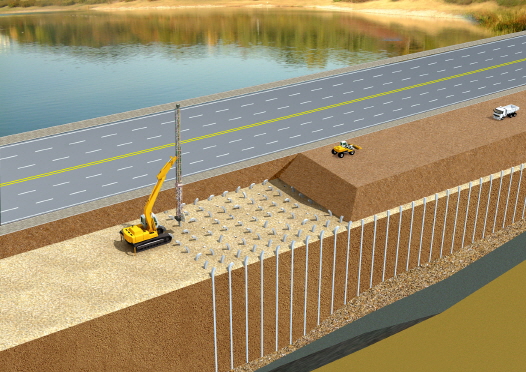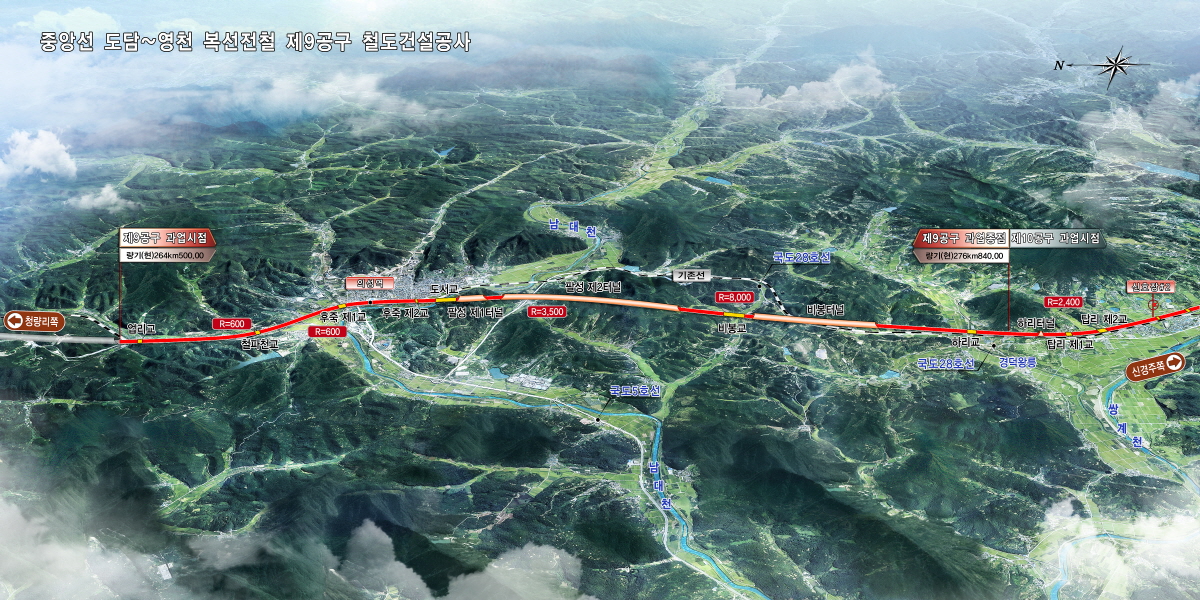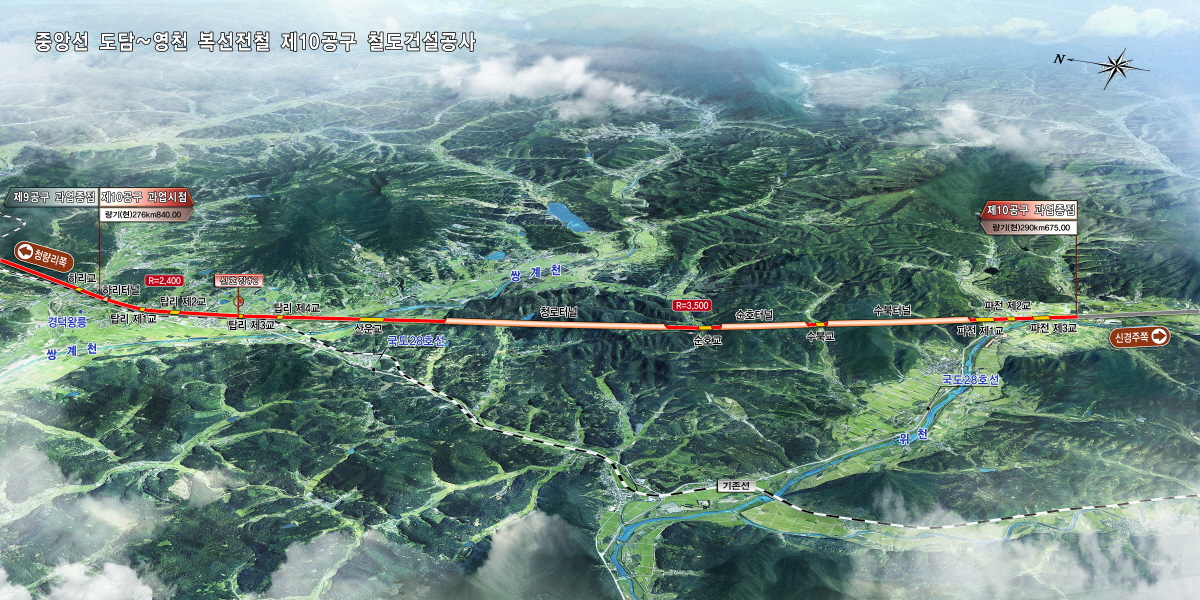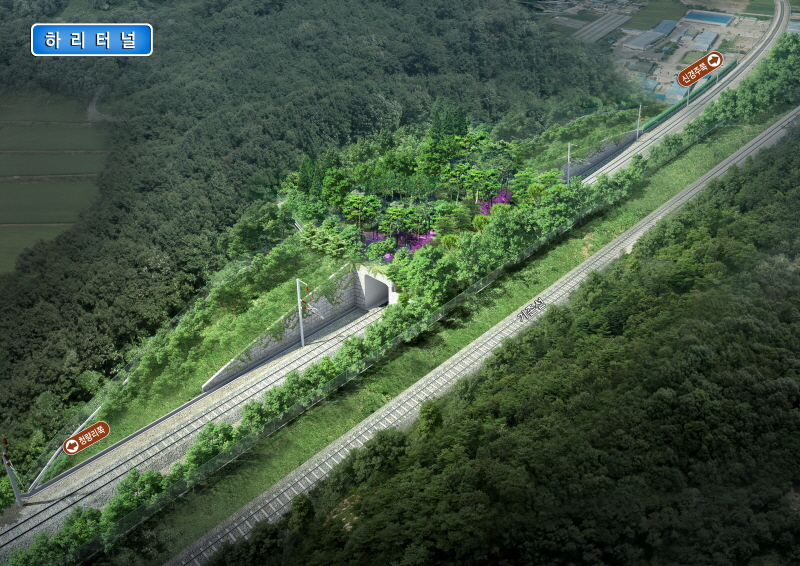

We are making unsparing investment into proposing of efficient and future-oriented policies, project planning and technological development. We recognize that the underground spaces and the geotechnical requirements in civil engineering design, associated with the establishment of social infrastructures such as road, railroads and harbors, etc. are the new growth engine and creative SOC project in the construction fields.
In addition, we are paying profound interest and efforts in the development of underground spaces including underwater tunnel, underground storage and underground dam on the basis of our experiences of having executed various overseas projects and large scale domestic projects. Moreover, we are putting in ceaseless efforts for the significant cultural heritage to be passed down to the next generations.
Project name: Dodam-Yeongcheon Double Track Railway Construction Project Lot 1 of Jungang Line(T/K)
Location: Eup-ri, Uiseong-eup, Uiseong-gun, Gyeongsangbuk-do ~ Yeongye-ri, Uiheung-myeon, Gunui-gun, Gyeongsangbuk-do
Purpose: Establishment of coherent transportation system that passes through the inland region in north-south direction through the electrification and high speed railway transportation of the existing Jungang Railway Line, and improvement of the railway services in the inland region of Gyeongbuk
The Commencement of the project
With the announcement of the basic plan for the project by the Ministry of Land, Infrastructure and Transport in April 2012, basic and detail design was commenced from November 2012 with the execution of the designing tunnel for the sector of the project.
Direction of planning & design
The alignment was established on the basis of the preliminary feasibility study (June 2010) and basic plan (December 2011), in which rational design standards were established prior to the Commencement of the design
Accordingly, there were 8 tunnels with the total length of approximately 13km. We commenced the design by planning the tunnel length to be approximately 30% of the entire route.
Conflicts with the local residents
With the completion of the basic design in March 2013, severe civil complaints were filed by the local residents regarding the Jeo Tunnel (approximately 2.9km) that passes through the Geumseong Mountain in Uiseong-gun, while carrying out public exhibition of the basic design to the residents of the local autonomous government in accordance with the relevant laws,
Details of the main civil complaints: Geumseong Mountain is a representative mountain of Uiseong-gun and the civil complaints were based on the worry that the flow of energy of the mountain can be severed by the tunnel. The Uiseong-gun Government also expressed the position that it is not possible to persuade the residents.
Respect for the local sentiments
Although alternative route was reviewed under the assessment that the planning and designing of the route that reflects the sentiments of the local residents must be abided, Uiseongtapriri, a 5-story stone pagoda designated as the National Treasure No. 77, was situated in the vicinity of the alternative route and negotiation with the Cultural Heritage Administration was unavoidable.
However, with the assertive support of the local residents and Uiseong-gun Government, we managed a plan to safely maintain
the cultural asset in December 2013.
Therefore, the route we chose the Geumseong Mountain using a total of 6 tunnels by passed with the total length of 11km.
Conceptual shifts
Civil complaints were filed during the execution of the detail design due to reasons including degradation of the views of the residents in the surrounding areas.
Therefore, we resolved such complaints by convincing the residents that civil engineering structures in accordance with the appropriate structural plan and landscaping plan are not the elements that hinder the absolute views, but rather facilities it by providing convenience to the daily lives of the residents.
Leading the tunnel design technology
The tunnel in the sector of the project was a single track tunnel with the designed speed of 250km per hour, which was unheard in Korea at the time. Accordingly, we accommodated the advice of the Korea Railroad Research Institute that there is a concern for the damages to the neighboring residences and residents due to the generation of sonic boom caused by speeding train in the tunnel.
The problem was resolved by using an innovative tunnel design technology by implementing a hood in the pit head section onto the design in order to reduce the sonic boom for the first time in the detail design of railroad in Korea
Sonic boom: Compression wave is formed at the time of entry of the rapid transit train into the tunnel, which will be disseminated towards the exit of the tunnel, thereby producing the phenomenon of the wave being radiated in the form of shock wave in noise format
Accumulation of experiences
The detail design was completed in April 2015 by considering the ground conditions, local sentiments and various civil petitions.
We successfully completed the design on the basis of the experiences accumulated while executing various overseas projects and large scale domestic projects. The experiences we obtained through this project was fully fed back and reflected in the future projects.
Completion of the design
The design that has encountered various issues including the sentiments of the local residents, shifting of the concepts, the first trial design in Korea, etc. was completed in July 2015
We confident that the railway stations and tunnels to be constructed through this project will provide convenience to the local residents and play a vital role as a landmark infrastructure in this region.


